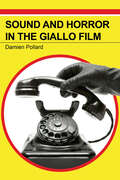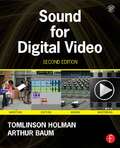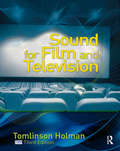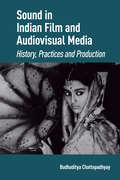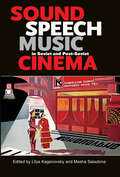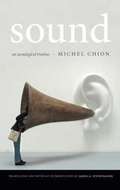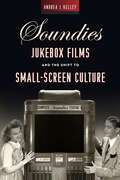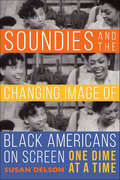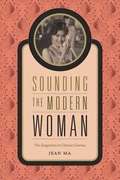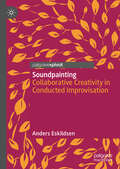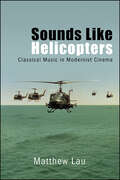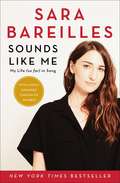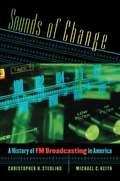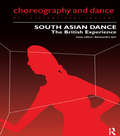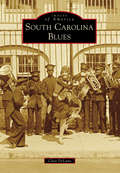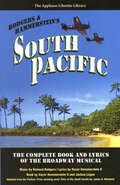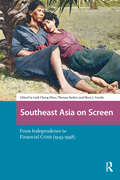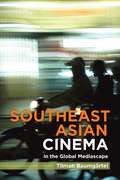- Table View
- List View
Sound and Horror in the Giallo Film (Icons of Horror)
by Damien PollardThe Italian giallo was a sleazy, violent, and stylistically baroque form of horror film that was produced in the hundreds from the 1960s to the 1980s. Sound and Horror in the Giallo Film listens closely to these films, asking how their soundtracks and their use of the human voice can help us understand the giallo's significance at a time when Italy was undergoing profound postwar social, economic, political, and cultural change.Throughout the history of Italian cinema, soundtracks have been a site of concerted and sustained intervention by political and economic forces. In Sound and Horror in the Giallo Film, author Damien Pollard argues that, because the giallo film pushed the boundaries of film form while also touting unapologetic commercialism, the voices on its soundtracks were both aesthetically exaggerated and directly shaped by commercial imperatives, which were influenced by Italy's turbulent postwar years. Featuring case studies of several well-known giallo films, including The Girl Who Knew Too Much, The Bird with the Crystal Plumage, and Tenebrae, Sound and Horror in the Giallo Film is an original analysis that reveals how the cinematic voice binds film and history.
Sound and Image: Aesthetics and Practices (Sound Design)
by Andrew Knight-HillSound and Image: Aesthetics and Practices brings together international artist scholars to explore diverse sound and image practices, applying critical perspectives to interrogate and evaluate both the aesthetics and practices that underpin the audiovisual. Contributions draw upon established discourses in electroacoustic music, media art history, film studies, critical theory and dance; framing and critiquing these arguments within the context of diverse audiovisual practices. The volume’s interdisciplinary perspective contributes to the rich and evolving dialogue surrounding the audiovisual, demonstrating the value and significance of practice-informed theory, and theory derived from practice. The ideas and approaches explored within this book will find application in a wide range of contexts across the whole scope of audiovisuality, from visual music and experimental film, to narrative film and documentary, to live performance, sound design and into sonic art and electroacoustic music. This book is ideal for artists, composers and researchers investigating theoretical positions and compositional practices which bring together sound and image.
Sound for Digital Video
by Arthur Baum Tomlinson HolmanAchieve professional quality sound on a limited budget! Harness all new, Hollywood style audio techniques to bring your independent film and video productions to the next level. In Sound for Digital Video, Second Edition industry experts Tomlinson Holman and Arthur Baum give you the tools and knowledge to apply recent advances in audio capture, video recording, editing workflow, and mixing to your own film or video with stunning results. This fresh edition is chockfull of techniques, tricks, and workflow secrets that you can apply to your own projects from preproduction through postproduction. New to this edition: A new feature on "true" 24p shooting and editing systems, as well as single vs. double-system recording A strong focus on new media, including mini-DVDs, hard disks, memory cards, and standard and high-definition imagery Discussion of camera selection, manual level control, camera and recorder inputs, location scouting, and preproduction planning Instruction in connectors, real-time transfers, and file-based transfers from DVDs, hard drives, and solid state media. Blu-Ray and HD tape formats for mastering and distribution in addition to file-based, DV, and DVD masters. A revamped companion website, www.focalpress.com/cw/holman, featuring recording and editing exercises, examples and sample tracks Whether you are an amateur filmmaker who wants to create great sound or an advanced professional in need of a reference guide, Sound for Digital Video, Second Edition is an essential addition to your digital audio tool belt.
Sound for Film and Television
by Tomlinson HolmanSound for Film and Television, Third Edition provides a thorough introduction to the fascinating field of recording, editing, mixing, and exhibiting film and television sound. It strikes a fine balance between aesthetic and technical content, combining theory and practice to approach sound as both an art and a science. This new edition has been completely updated to reflect the latest advances in HD technology, new hardware and software systems, new distribution methods, wireless sound capture, and more. Also, analog-related content has been reduced and transferred to the chapters covering historical techniques. Sections on troubleshooting and FAQs have been added to help you avoid common pitfalls in sound production. Written by one of Hollywood's leading sound experts, Sound for Film and Television provides a solid grounding in all aspects of the sound process. Basic principles are presented with illustrations demonstrating how they affect the day-to-day activities on a film or television set, in the editing room, and in the mix room. The accompanying audio DVD contains more than 50 tracks that demonstrate practical, real-world examples of key concepts presented in the book. A companion Web site provides further resources and information: http://booksite.focalpress.com/companion/Holman/SoundforFilmandTelevision/ Please use the access code located in the beginning of the book to register for access to the Web site.
Sound in Indian Film and Audiovisual Media: History, Practices and Production
by Budhaditya ChattopadhyayThis book is the first ever systematic attempt to study film sound in the Indian subcontinent by artistic research. The book aims to fill the scholarly void on the issues of sound and listening in the Global Souths’ cultures. It develops a comprehensive understanding of the unique sound world of Indian film and audiovisual media through the examination of historical developments of sound from early optical recordings to contemporary digital audio technologies. The book is enriched with a practice-based methodology informed by the author’s own practice and based on extensive conversations with leading sound practitioners in the Indian subcontinent. The book locates an emerging social and spatial awareness in Indian film and media production aided by a creative practice of sound, occurring alongside the traditionally transcendental, oral, and pluriversal approach to listening. By tracing this confluence of tradition and modernity, the book makes valuable contributions to the fields of film history, sound, and media studies.
Sound, Media, Ecology (Palgrave Studies in Audio-Visual Culture)
by Milena Droumeva Randolph JordanThis volume reads the global urban environment through mediated sonic practices to put a contemporary spin on acoustic ecology’s investigations at the intersection of space, cultures, technology, and the senses. Acoustic ecology is an interdisciplinary framework from the 1970s for documenting, analyzing, and transforming sonic environments: an early model of the cross-boundary thinking and multi-modal practices now common across the digital humanities. With the recent emergence of sound studies and the expansion of “ecological” thinking, there is an increased urgency to re-discover and contemporize the acoustic ecology tradition. This book serves as a comprehensive investigation into the ways in which current scholars working with sound are re-inventing acoustic ecology across diverse fields, drawing on acoustic ecology’s focus on sensory experience, place, and applied research, as well as attendance to mediatized practices in sounded space. From sounding out the Anthropocene, to rethinking our auditory media landscapes, to exploring citizenship and community, this volume brings the original acoustic ecology problem set into the contemporary landscape of sound studies.
Sound, Speech, Music in Soviet and Post-Soviet Cinema
by Masha Salazkina Lilya KaganovskyThis innovative volume challenges the ways we look at both cinema and cultural history by shifting the focus from the centrality of the visual and the literary toward the recognition of acoustic culture as formative of the Soviet and post-Soviet experience. Leading experts and emerging scholars from film studies, musicology, music theory, history, and cultural studies examine the importance of sound in Russian, Soviet, and post-Soviet cinema from a wide range of interdisciplinary perspectives. Addressing the little-known theoretical and artistic experimentation with sound in Soviet cinema, changing practices of voice delivery and translation, and issues of aesthetic ideology and music theory, this book explores the cultural and historical factors that influenced the use of voice, music, and sound on Soviet and post-Soviet screens.
Sound: An Acoulogical Treatise
by James A. Steintrager Michel ChionFirst published in French in 1998, revised in 2010, and appearing here in English for the first time, Michel Chion's Sound addresses the philosophical, interpretive, and practical questions that inform our encounters with sound. Chion considers how cultural institutions privilege some sounds above others and how spurious distinctions between noise and sound guide the ways we hear and value certain sounds. He critiques the tenacious tendency to understand sounds in relation to their sources and advocates "acousmatic" listening--listening without visual access to a sound's cause--to disentangle ourselves from auditory habits and prejudices. Yet sound can no more be reduced to mere perceptual phenomena than encapsulated in the sciences of acoustics and physiology. As Chion reminds us and explores in depth, a wide range of linguistic, sensory, cultural, institutional, and media- and technologically-specific factors interact with and shape sonic experiences. Interrogating these interactions, Chion stimulates us to think about how we might open our ears to new sounds, become more nuanced and informed listeners, and more fully understand the links between how we hear and what we do.
Soundies Jukebox Films and the Shift to Small-Screen Culture (Techniques of the Moving Image)
by Andrea J. KelleySoundies Jukebox Films and the Shift to Small-Screen Culture is the first and only book to position what are called “Soundies” within the broader cultural and technological milieu of the 1940s. From 1940 to 1946, these musical films circulated in everyday venues, including bars, bowling alleys, train stations, hospitals, and even military bases. Viewers would pay a dime to watch them playing on the small screens of the Panoram jukebox. This book expands U.S. film history beyond both Hollywood and institutional film practices. Examining the dynamics between Soundies’ short musical films, the Panoram’s film-jukebox technology, their screening spaces and their popular discourse, Andrea J. Kelley provides an integrative approach to historic media exhibition. She situates the material conditions of Soundies’ screening sites alongside formal considerations of the films and their unique politics of representation to illuminate a formative moment in the history of the small screen.
Soundies and the Changing Image of Black Americans on Screen: One Dime at a Time
by Susan DelsonIn the 1940s, folks at bars and restaurants would gather around a Panoram movie machine to watch three-minute films called Soundies, precursors to today's music videos. This history was all but forgotten until the digital era brought Soundies to phones and computer screens—including a YouTube clip starring a 102-year-old Harlem dancer watching her younger self perform in Soundies. In Soundies and the Changing Image of Black Americans on Screen: One Dime at a Time, Susan Delson takes a deeper look at these fascinating films by focusing on the role of Black performers in this little-known genre. She highlights the women performers, like Dorothy Dandridge, who helped shape Soundies, while offering an intimate look at icons of the age, such as Duke Ellington and Nat King Cole. Using previously unknown archival materials—including letters, corporate memos, and courtroom testimony—to trace the precarious path of Soundies, Delson presents an incisive pop-culture snapshot of race relations during and just after World War II.Perfect for readers interested in film, American history, the World War II era, and Black entertainment history, Soundies and the Changing Image of Black Americans on Screen and its companion video website (susandelson.com) bring the important contributions of these Black artists into the spotlight once again.
Sounding the Modern Woman: The Songstress in Chinese Cinema
by Jean MaFrom the beginning of the sound cinema era, singing actresses captivated Chinese audiences. In Sounding the Modern Woman, Jean Ma shows how their rise to stardom attests to the changing roles of women in urban modernity and the complex symbiosis between the film and music industries. The songstress--whether appearing as an opera actress, showgirl, revolutionary, or country lass--belongs to the lineage of the Chinese modern woman, and her forty year prevalence points to a distinctive gendering of lyrical expression in Chinese film. Ma guides readers through film history by way of the on and off-screen careers of many of the most compelling performers in Chinese film history, such as Zhou Xuan and Grace Chang, revealing the ways that national crises and Cold War conflict shaped their celebrity. As a bridge between the film cultures of prewar Shanghai and postwar Hong Kong, the songstress brings into view a dense web of connections linking these two periods and places that cut across the divides of war, national politics, and geography.
Soundpainting: Collaborative Creativity in Conducted Improvisation (Palgrave Studies in Sound)
by Anders EskildsenThis book explores Soundpainting, a multidisciplinary sign language for live composition and conducted improvisation, highlighting its role in facilitating creative, social interactions in music and other performative arts. Examining the meaning of Soundpainting’s syntax, the connection between constraints and creativity in hand signs, and the means for dynamic distribution and transformation of agency within ensembles, the book provides insight into the nature of cocreation and the organization of creative processes.
Sounds Like Helicopters: Classical Music in Modernist Cinema (SUNY series, Horizons of Cinema)
by Matthew LauExplores how modernist films use classical music in ways that restore the music's original subversive energy.Classical music masterworks have long played a key supporting role in the movies-silent films were often accompanied by a pianist or even a full orchestra playing classical or theatrical repertory music-yet the complexity of this role has thus far been underappreciated. Sounds Like Helicopters corrects this oversight through close interpretations of classical music works in key modernist films by Francis Ford Coppola, Werner Herzog, Luis Buñuel, Stanley Kubrick, Jean-Luc Godard, Michael Haneke, and Terrence Malick. Beginning with the famous example of Wagner's "Ride of the Valkyries" in Apocalypse Now, Matthew Lau demonstrates that there is a significant continuity between classical music and modernist cinema that belies their seemingly ironic juxtaposition. Though often regarded as a stuffy, conservative art form, classical music has a venerable avant-garde tradition, and key films by important directors show that modernist cinema restores the original subversive energy of these classical masterworks. These films, Lau argues, remind us of what this music sounded like when it was still new and difficult; they remind us that great music remains new music. The pattern of reliance on classical music by modernist directors suggests it is not enough to watch modernist cinema: one must listen to its music to sense its prehistory, its history, and its obscure, prophetic future.
Sounds Like Me: My Life (So Far) in Song
by Sara BareillesAn anniversary edition of The New York Times bestselling collection of essays by two-time Grammy Award winner, creator of Little Voice on Apple TV+, and star of Netflix&’s Girls5eva Sara Bareilles &“resonates with authentic and hard-won truths&” (Publishers Weekly)—and features new material on the hit Broadway musical Waitress.Sara Bareilles &“pours her heart and soul into these essays&” (Associated Press), sharing the joys and the struggles that come with creating great work, all while staying true to yourself. Imbued with humor and marked by Sara&’s confessional writing style, this essay collection tells the inside story behind some of her most popular songs. Well known for her chart-topper &“Brave,&” Sara first broke through in 2007 with her multi-platinum single &“Love Song.&” She has since released seven studio albums that have sold millions of copies and spawned several hits, not to mention creating and starring in the hit Broadway musical Waitress. &“A breezy, upbeat, and honest reflection of this multitalented artist&” (Kirkus Reviews), Sounds Like Me reveals Sara Bareilles, the artist—and the woman—on songwriting, soul-searching, and what&’s discovered along the way.
Sounds of Change
by Michael C. Keith Christopher H. SterlingWhen it first appeared in the 1930s, FM radio was a technological marvel, providing better sound and nearly eliminating the static that plagued AM stations. It took another forty years, however, for FM's popularity to surpass that of AM. In Sounds of Change, Christopher Sterling and Michael Keith detail the history of FM, from its inception to its dominance (for now, at least) of the airwaves.Initially, FM's identity as a separate service was stifled, since most FM outlets were AM-owned and simply simulcast AM programming and advertising. A wartime hiatus followed by the rise of television precipitated the failure of hundreds of FM stations. As Sterling and Keith explain, the 1960s brought FCC regulations allowing stereo transmission and requiring FM programs to differ from those broadcast on co-owned AM stations. Forced nonduplication led some FM stations to branch out into experimental programming, which attracted the counterculture movement, minority groups, and noncommercial public and college radio. By 1979, mainstream commercial FM was finally reaching larger audiences than AM. The story of FM since 1980, the authors say, is the story of radio, especially in its many musical formats. But trouble looms. Sterling and Keith conclude by looking ahead to the age of digital radio--which includes satellite and internet stations as well as terrestrial stations--suggesting that FM's decline will be partly a result of self-inflicted wounds--bland programming, excessive advertising, and little variety.When it first appeared in the 1930s, FM radio was a technological marvel, providing better sound and nearly eliminating the static that plagued AM stations. It took another forty years, however, for FM's popularity to surpass that of AM. In Sounds of Change, Christopher Sterling and Michael Keith detail the history of FM, from its inception to its dominance (for now, at least) of the airwaves.Initially, FM's identity as a separate service was stifled, since most FM outlets were AM-owned and simply simulcast AM programming and advertising. But the 1960s brought FCC regulations allowing stereo transmission and requiring FM programs to differ from those broadcast on co-owned AM stations. Branching out into experimental programming, FM soon attracted the counterculture movement, minority groups, and noncommercial public and college radio. By 1979, mainstream commercial FM was finally reaching larger audiences than AM. Recent decades have been FM's heyday. But trouble looms. Sterling and Keith conclude by looking ahead to the age of digital radio--which includes satellite and internet stations as well as terrestrial stations--suggesting that FM's eventual decline will be partly a result of self-inflicted wounds--bland programming, excessive advertising, and little variety.-->
Soupy Sez!: My Zany Life and Times
by Soupy SalesIn the 1960's Soupy Sales was a national phenomenon with his whimsical, live TV show and the hottest record in America.
South African National Cinema (National Cinemas)
by Jacqueline MaingardSouth African National Cinema examines how cinema in South Africa represents national identities, particularly with regard to race. This significant and unique contribution establishes interrelationships between South African cinema and key points in South Africa’s history, showing how cinema figures in the making, entrenching and undoing of apartheid. This study spans the twentieth century and beyond through detailed analyses of selected films, beginning with De Voortrekkers (1916) through to Mapantsula (1988) and films produced post apartheid, including Drum (2004), Tsotsi (2005) and Zulu Love Letter (2004). Jacqueline Maingard discusses how cinema reproduced and constructed a white national identity, taking readers through cinema’s role in building white Afrikaner nationalism in the 1930s and 1940s. She then moves to examine film culture and modernity in the development of black audiences from the 1920s to the 1950s, especially in a group of films that includes Jim Comes to Joburg (1949) and Come Back, Africa (1959). Jacqueline Maingard also considers the effects of the apartheid state’s film subsidy system in the 1960s and 1970s and focuses on cinema against apartheid in the 1980s. She reflects upon shifting national cinema policies following the first democratic election in 1994 and how it became possible for the first time to imagine an inclusive national film culture. Illustrated throughout with excellent visual examples, this cinema history will be of value to film scholars and historians, as well as to practitioners in South Africa today.
South American Cinema: A Critical Filmography 1915-1994
by Timothy Barnard Peter RistOriginally issued in hardcover in 1996 by Garland Publishing, this important reference work is now available in paperback for a wider audience. A distinguished team of contributors has compiled entries on 140 significant South American feature films from the silent era until 1994. The entries discuss each film's subject matter, critical reception, and social and political contexts, as well as its production, distribution, and exhibition history, including technical credits. The entries are grouped by country and arranged chronologically. Both fiction and documentary films (some no longer in existence) are included, as well as extensive title, name, and subject indexes and glossaries of film and foreign terms.
South Asia in Alternative Cinema(s)
by Vivek Sachdeva Hariprasad Athanickal Chandrakant A. LangareSouth Asia in Alternative Cinema(s) explores the significance and relevance of parallel, the new wave, the new middle cinema, avant-garde and independent cinemas from and on India, Pakistan, Bhutan, Sri Lanka, Bangladesh and other parts of South Asia. The scholarly and groundbreaking articles interrogate, in a global context, intersecting social, political and cultural issues and offer a rich discourse on the works of eminent filmmakers and their cinematic compositions. The original articles focus on the “New Wave” in Hindi, Kannada, Bengali, Malayalam, Assamese and other regional languages of India, as well as experimental/independent films from and on India, Pakistan, Bhutan, Bangladesh, Sri Lanka and other parts of South Asia, irrespective of the language in which they are made.The book also offers new insights and a fresh perspective on the contentious intellectual relation between human life and its reflection in cinemas.
South Asian Dance: The British Experience
by Alessandra IyerFirst Published in 1998. Routledge is an imprint of Taylor & Francis, an informa company.
South Carolina Blues
by Clair DeluneThe history of South Carolina blues is a long, deep--and sometimes painful--story. However, it is a narrative with aspects as compelling as the music itself. Geographical differences in America led to variations in the styles of music that developed from African rhythms. The wet, marshy landscape and hot, muggy weather of the Carolina Lowcountry combined to cultivate not only rice, but a Gullah-based style of South Carolina blues. In drier climates, toward the Midlands and the Upstate, the combination of European influences led to the emergence of Piedmont blues, which in turn spawned country music as well as bluegrass. Those same Gullah roots resulted in four major dance crazes, starting with the Charleston.
South Jersey Movie Houses
by Allen F. HaussSince the early 1900s, when the first moving images flickered on the screens of storefront nickelodeons, going to the movies has been an integral part of life across America. By the 1950s, there were over 230 theaters in southern New Jersey, ranging from lavish palaces like the 2,000-seat Stanley in Camden to modest venues like the 350-seat Little in Haddonfield. Today, sadly, less than a dozen remain standing, and most of those are now used for other commercial purposes. Only the Broadway in Pitman continues to operate as the last of the original motion-picture palaces. South Jersey Movie Houses is a pictorial tour of the theaters that once raised their curtains to audiences across the southern part of the state. It offers a nostalgic look at their neon marquees and silver screens, bringing back memories of Saturday matinees, 3-D glasses, and movie date nights.
South Pacific: The Complete Book and Lyrics of the Broadway Musical
by Richard Rodgers Oscar Hammerstein IIWinner of the Pulitzer Prize for Drama and the Tony for Best Musical, South Pacific flourished as the golden musical of Broadway's post-WWII golden era. Nearly 60 years after its 1949 premiere, South Pacific returned to Broadway in Lincoln Center Theater's glorious Tony-winning production, setting box-office records and bringing this timely and timeless musical to new generations. With a score by Rodgers & Hammerstein and a libretto by Hammerstein and Joshua Logan, based on James A. Michener's Pulitzer Prize-winning novel, Tales of the South Pacific, this landmark musical combines compassionate love stories with the saga of a world at war. Richly developed characters are faced with life-changing moments in a complex world, their thoughts and yearnings powerfully expressed in the lyrics to such songs as “This Nearly Was Mine ” “Younger Than Springtime ” and “Some Enchanted Evening.”
Southeast Asia on Screen: From Independence to Financial Crisis (1945-1998) (Asian Visual Cultures)
by Thomas Barker Mary J. Ainslie Gaik Cheng KhooAfter the end of World War II when many Southeast Asian nations gained national independence, and up until the Asian Financial Crisis, film industries here had distinctive and colourful histories shaped by unique national and domestic conditions. Southeast Asia on Screen: From Independence to Financial Crisis (1945-1998) addresses the similar themes, histories, trends, technologies and sociopolitical events that have moulded the art and industry of film in this region, identifying the unique characteristics that continue to shape cinema, spectatorship and Southeast Asian filmmaking in the present and the future. Bringing together scholars across the region, chapters explore the conditions that have given rise to today's burgeoning Southeast Asian cinemas as well as the gaps that manifest as temporal belatedness and historical disjunctures in the more established regional industries.
Southeast Asian Independent Cinema
by Tilman BaumgartelThe rise of independent cinema in Southeast Asia, and the emergence of a new generation of filmmakers there, is among the most significant recent developments in global cinema. The advent of affordable and easy access to digital technology has empowered new voices from a part of the world rarely heard or seen in international film circles. This book documents these developments as a genuine outcome of the democratization and liberalization of film production of films. Interviewees include Lav Diaz, Amir Muhammad, Apichatpong Weerasethakul, Eric Khoo, Garin Nugroho, Nia Dinata and others.
